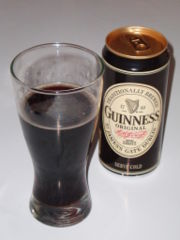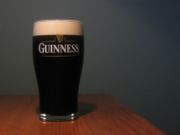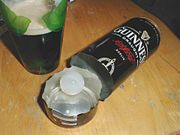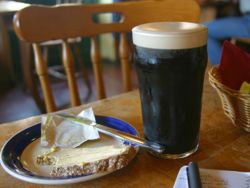Guinness
2007 Schools Wikipedia Selection. Related subjects: Drink
Guinness is a dry stout that originated in Arthur Guinness's St. James's Gate Brewery in Dublin, Ireland. The beer is based upon the porter style that originated in London in the early 1700s. It is one of the most successful beer brands in the world, being exported world wide. It has spawned many imitators. The distinctive feature in the flavour is the roasted barley which remains unfermented. For many years a portion of the beer was aged to give a sharp lactic flavour, but Guinness has refused to confirm if this still occurs. The thick creamy head is the result of a nitrogen mix being added during the serving process.
Now available around the world, the brand is still heavily associated with Ireland, though the parent company has been headquartered in London since 1932, and was later developed into a multi-national alcohol conglomerate and re-named Diageo.
Composition
Guinness stout is made from water, barley malt, hops, and brewers yeast. A portion of the barley is flaked (i.e. steamed and rolled) and roasted to give Guinness its dark-ruby colour and characteristic taste. It is pasteurised and filtered. Despite its reputation as a "meal in a glass" or "liquid bread", Guinness only contains 198 calories (838 kilojoules) per imperial pint (20oz UK) (1460 kJ/ L), less than an equal-sized serving of skimmed milk or orange juice and most other non-light beers. Guinness is not suitable for vegans and most vegetarians due to the use of a fish-based fining agent called isinglass.
The water used comes from Lady's Well in the Wicklow Mountains.
Draught Guinness and its canned counterpart contain nitrogen (N2) as well as carbon dioxide. Unlike carbon dioxide, nitrogen does not dissolve in water, which allows the beer to be put under high pressure without making it fizzy. The high pressure is required to force the draught beer through fine holes in a plate in the tap, which causes the characteristic "surge" (the widget in cans and bottles achieves the same effect). The perceived smoothness of draught Guinness is due to the low acidity and the creaminess of the head caused by the nitrogen. "Original Extra Stout" tastes quite different; it contains only carbon dioxide, causing a more acidic taste.
Contemporary Guinness Draught and Extra Stout are weaker than they were in the 19th century, when they had an original gravity of over 1070. Foreign Extra Stout and Special Export Stout, with ABV over 7%, are perhaps closest to the original in character.
From start to finish, the whole process is completed within 10 days.
History
Arthur Guinness started brewing ales initially in Leixlip, then at the St. James's Gate Brewery, Dublin, Ireland from 1759. He signed a 9,000 year lease at £45 per annum for the unused brewery. Ten years later in 1769 Guinness exported their product for the first time, when six and a half barrels were shipped to England.
Although sometimes believed to have originated the stout style of beer, the first use of the word stout in relation to beer was in a letter in the Egerton Manuscript dated 1677, almost 50 years before Arthur Guinness was born. The first use of the word stout in the context of a Guinness beer was their Stout-Porter of 1820.
Guinness brewed their last porter in 1974.
Guinness Stout is also brewed under licence internationally.
The Guinness brewery in Park Royal, London closed in 2005. The production of all Guinness sold in the UK was switched to St. James's Gate Brewery Dublin. People had previously in the UK stated that Irish brewed Guinness tasted much better than that brewed in London.
Varieties
Guinness stout is available in a number of variants and strengths, which include:
- Guinness Draught, sold in kegs—4.1 to 4.3% alcohol by volume (abv);
- Extra Cold Draught, sold in kegs and put through a super cooler—4.1 to 4.3% abv;
- Bottled Guinness Draught, which includes a patented "rocket widget" to simulate the draught taste—4.1 to 4.3% abv;
- Canned Guinness Draught, which includes a similar but differently shaped widget—4.1 to 4.3% abv;
- Guinness Original/Extra Stout, as near to Arthur Guinness's original porter as can be obtained today—4.2 or 4.3% abv (Ireland, UK), 5% abv (Canada, mainland Europe), and 6% abv (United States, Australia, Japan);
- Guinness Foreign Extra Stout, sold in Ireland, Africa, the Caribbean and Asia—5% abv (China), 6.5% abv (Jamaica, East Africa), 7.5% abv (Ireland, West Africa, Indonesia, St. Kitts & Nevis) and 8% abv (Malaysia), blended with a small amount of intentionally soured beer to balance the flavour;
- Guinness Foreign Extra Stout Nigeria, uses sorghum in the brewing process instead of barley because of restrictions on barley cultivation. Sold in Nigeria (the third largest and fastest-growing Guinness market in the world) and Great Britain—7.5% abv;
- Guinness Special Export Stout, sold in Belgium—8% abv;
- Guinness Bitter, an English-style bitter beer—4.4% abv;
- Guinness Extra Smooth, a smoother stout sold in Ghana, Cameroon and Nigeria—5.5% abv;
- Malta Guinness, a non-alcoholic sweet drink, sold in Africa, Malaysia;
- Guinness Mid-Strength, a low-alcohol stout being test-marketed in Limerick, Ireland from March 2006—2.8% abv;
- Guinness Red, a red ale that bears the Guinness name that will begin test-marketing in Great Britain in early 2007.
- In October 2005, Guinness introduced the Brewhouse Series — a limited-edition collection of draft stouts that will be available for six months each. The first stout in the series was Brew 39, which was released in Dublin from Autumn 2005 until Spring 2006. It had the same alcohol content (abv) as Guinness Draught, used the same gas mix and settled in the same way, but had a slightly different taste.
- In May 2006, the second in the Brewhouse Series was introduced, named Toucan Brew after the famous Guinness Toucan seen in many advertisements for the stout. This beer was said to have a crisper taste due to its triple-hopped brewing process.
- The third of the series - North Star Brew - was released in October 2006. It uses the same ingredients as Guinness Draught but features a more well-rounded finish due to a slight change in the blend of barley malts.
- In March 2006, Guinness introduced the "surger" in Great Britain. The surger is a plate-like electrical device meant for the home. It sends ultrasonic waves through a Guinness-filled pint glass to recreate the beer's famous "surge and settle" effect. The device works in conjunction with special cans of surger-ready Guinness. Guinness had tested the surger since 2003 in Japanese bars, most of which are too small to accommodate traditional keg-and-tap systems. The surger has since been introduced to bars in Paris, France but with no intention of making it available to the public.
- Withdrawn Guinness variants include Guinness's Brite Lager, Guinness's Brite Ale, Guinness Light, Guinness XXX Extra Strong Stout, Guinness Cream Stout, Guinness Gold, Guinness Pilsner and Guinness Special Light.
- A brewing byproduct of Guinness, Guinness Yeast Extract (GYE), was produced until the 1950s.
Pouring and serving
Draught Guinness is served cool with the beer line run through a cooler or a super cooler to chill the liquid to the required temperature. Due to the foaming action of the nitrogen it can take a while for the beer to settle as it is poured, often requiring a pause. Guinness has made a virtue of this wait with advertising campaigns such as "good things come to those who wait" and "it takes 119.5 seconds to pour the perfect pint".
To guarantee a perfect pint there are 5 basic steps to follow: step 1 is to make sure the glass is clean and rinsed with cold water. Step 2 pour the Guinness in with the glass tilted at 45 degrees, until it is 2/3rds full. Step 3 wait until it settles. Step 4 with the glass on the bar very slowly fill the rest of the glass until the head reaches the top. Step 5 wait for it to settle.
Some bartenders also draw a simple design, using the head of the tap, such as a shamrock in the head during the slow pour.
Sinking bubbles
A long time subject of bar conversations is the Guinness cascade, where the gas bubbles appear to travel downwards in a pint glass of Guinness.
The effect is attributed to drag; bubbles that touch the walls of a glass are slowed in their travel upwards. Bubbles in the centre of the glass are, however, free to rise to the surface, and thus form a rising column of bubbles. The rising bubbles create a current by the entrainment of the surrounding fluid. As beer rises in the centre, the beer near the outside of the glass falls. This downward flow pushes the bubbles near the glass towards the bottom. Although the effect occurs in any liquid, it is particularly noticeable in any dark nitrogen stout, as the drink combines dark-coloured liquid and light-coloured bubbles.
Advertising
Guinness uses the harp of Brian Boru, or Trinity College Harp as their trademark. This circa 14th century harp which is still visible at Trinity College, Dublin has been used as a symbol of Ireland since the reign of Henry VIII (16th century). Guinness adopted the harp as a logo in 1862, however it is shown in a form that faces left instead of right as in the coat of arms.
Guinness has a long history of marketing campaigns, from award-winning television commercials to beer mats and posters.
Guinness's iconic stature can be attributed in part to its advertising. The most notable and recognisable series of adverts was created by Benson's advertising, primarily drawn by the artist John Gilroy, in the 1930s and 40s. Benson's was responsible for creating posters which included such phrases such as "Guinness for Strength", "Lovely Day for a Guinness", "Guinness Makes You Strong," "Drink Guinness for a healthy baby and painless birth", "My Goodness My Guinness," (or, alternatively, "My Goodness, My Christmas, It's Guinness!") and most famously, "Guinness is Good For You". The posters featured Gilroy's distinctive artwork and more often than not featured animals such as a kangaroo, ostrich, seal, lion, and notably a toucan, which has become as much a symbol of Guinness as the harp. (An advertisement from the 1940s ran with the following jingle: Toucans in their tests agree/Guinness is good for you./Try some today and see/What one or toucan do.) Dorothy L. Sayers, then a copywriter at Benson's, also worked on the campaign; a biography of Sayers notes that she created a sketch of the toucan and wrote several of adverts in question. Guinness has recently taken the dominant share in the African beer market with its Michael Power advertising campaign. Guinness advertising paraphernalia attracts high prices on the collectible market.
In 2000, Guinness's 1999 advert Surfer was named the best television commercial of all time in a UK poll conducted by The Sunday Times and Channel 4. Surfer was produced by the advertising agency Abbott Mead Vickers BBDO; the advertisement can be downloaded from their website.
Guinness was awarded the 2001 Clio Award as the Advertiser of the Year, citing the work of five separate ad agencies around the world.
Recently, commercials for Guinness Draught have been using paper cutout animation (in the style of Terry Gilliam's Monty Python animations) featuring two scientists. One scientist claims that Guinness Draught "has only 129 calories", to which the assistant responds "BRILLIANT!". He then goes on to claim his invention of an early version of something such as a telephone, to which the assistant also responds "BRILLIANT!". Then they toast. Sometimes, there is a joke entered, such as the rejection of the scientist during the "little black book" commercial, in which he claims "you can also use it as a coaster", also deemed "BRILLIANT!". 2005 Their commercial won in the European Epic Award where 3 men after drinking Guiness walking backward and evolve backward as well being an ancient homo sapient, monkey, flying lemur, pandolin, ichynisaurus, velociraptor until it became a mud skipper which was drinking an "Ancient" form of Guiness. There are two spin-off versions of this advert, promoting the Extra Cold variety.
Despite widespread advertising, sales of Guinness have been falling in Ireland since 1998, with a 3% decline since August 2005. It has, however, become more popular in the US, displaying a 9% sales increase.
Merchandising
During Saint Patrick's Day, Guinness merchandise is available in many places that sell the drink. Merchandise includes clothing and hats, often available from behind the bar after a specified number of pints of Guinness have been purchased.
There is an exhibition on Guinness at St. James's Gate Brewery in Dublin, called the Guinness Storehouse, where some of the old brewing equipment is on show, as well as old advertising posters.
Trivia
- The band Dropkick Murphys wrote a song called "Good Rats" about a rumor regarding the Guinness brewery of how rats were found once when cleaning the vats. Then after the vats were sterilized, people weren't impressed with the taste because supposedly the rats gave it an extra kick.
- The folk punk band Against Me! has a track titled "Pints of Guinness Make You Strong" on their 2002 record Reinventing Axl Rose.
- There is a drink called a Crown Float that combines one part Guinness stout "floated" on top of one part Strongbow Cider.
- There is a drink called an Irish Car Bomb which involves mixing one pint of Guiness with shots of whiskey and Irish Cream.
- In the 1993 film Mrs. Doubtfire, Mrs. Doubtfire tells the story of how her husband died. She describes that he was "quite fond of the drink. It was the drink that killed him.", to which Sally Field replied, "He was an alcoholic?" Mrs Doubtfire retorted, "No, he was hit by a Guinness truck."
- Professional wrestler Nigel McGuinness uses a modified Guinness logo on his merchandise.
- In the recent "suntan" commercial, one can notice that in the last few moments of the cartoon after the final "BRILLIANT!", one of the two men raises his suntan lotion instead of his beer, and motions as if about to drink it just before the commercial ends.
- The Fugees mention Guinness in "How Many Mikes" from their breakthrough album, The Score
- Contrary to popular belief, Guinness is not a good source of iron, containing only 0.3 mg per pint, given that the RDA (recommended daily allowance) of iron is between 11mg and 18mg the amount contained in a pint of Guinness is trivial. In comparisson, a bowl of Weetabix contains 4.2mg of iron, meaning that a person would have to drink 14 pints of Guinness to get the same amount of iron contained in one bowl of weetabix. Source: VHI ( Vhi Healthcare)



